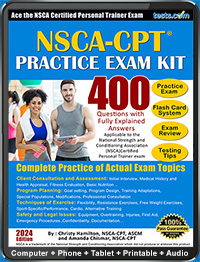2025 Edition
NSCA CSCS Practice Exam
Take this free NSCA Certified Strength and Conditioning Specialist practice exam to get an idea of the type of questions that appear on the actual certification exam.
The NSCA CSCS exam covers main two subject areas: Scientific Foundations and Practial/Applied. The sections are broken down as follows:
Scientific Foundations (95 questions; 1.5 hours)
- Exercise Science
- Nutrition
- Exercise Technique
- Program Design
- Organization and Administration
- Testing and Evaluatio


